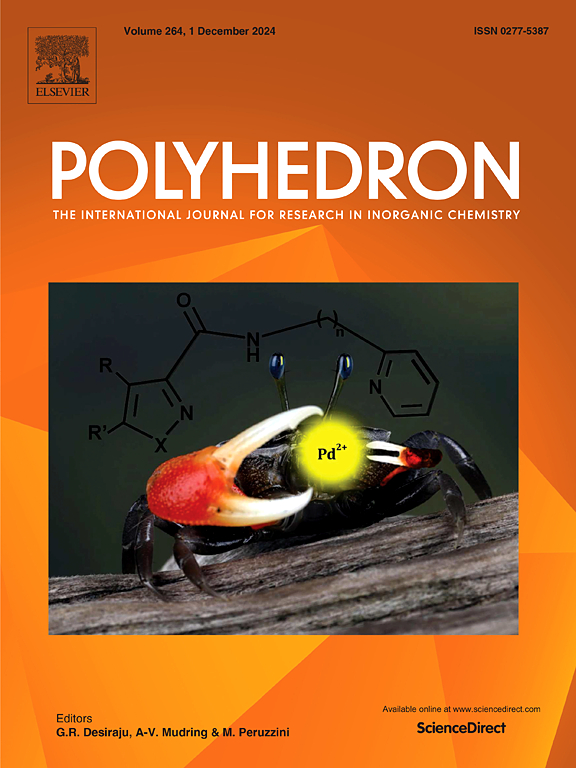Theoretical insights into the separation of Am(III) and Eu(III) using N,O-hybrid ligands based on difuran skeletons
IF 2.4
3区 化学
Q2 CHEMISTRY, INORGANIC & NUCLEAR
引用次数: 0
Abstract
The separation of minor actinides and lanthanides is a challenging step in high-level nuclear waste disposal. Designing ligands with An(III)/Ln(III) efficient separation performance remains an important task for the treatment of accumulated radioactive waste and the recovery of minor actinides. In this article, we introduce eight symmetrical N,O-hybrid ligands formed from furan and N heterocycles, and systematically study the properties of these ligands and the coordination structures, bonding properties and thermodynamic behaviors of their Am(III)/Eu(III) complexes. All analyses of the geometric structure, Wiberg bond index, QTAIM, and NBO of the complexes indicate that the chemical bonds formed between Am(III) and the ligand have more covalent characteristics and are stronger than the bond between Eu(III) and the ligand. The thermodynamic results show that the eight extractants have good extraction ability and separation performance for Am(III) and Eu(III). This study shows that ligand rigidity and side-chain nitrogen atoms significantly influence bonding strength and separation efficiency for Am(III) and Eu(III), and that the ligand L1 formed by non-rigid skeleton and pyridine side chain have the strongest extraction ability and the best separation performance. This study provides some theoretical support for the design of N,O-hybrid extractants for the effective separation of lanthanides and actinides.

基于二呋喃骨架的N, o杂化配体分离Am(III)和Eu(III)的理论见解
微量锕系元素和镧系元素的分离是高放核废料处理中一个具有挑战性的步骤。设计具有An(III)/Ln(III)高效分离性能的配体仍然是放射性废物处理和微量锕系元素回收的重要任务。本文介绍了由呋喃和N杂环形成的8种对称N, o杂化配体,系统地研究了这些配体的性质及其Am(III)/Eu(III)配合物的配位结构、成键性质和热力学行为。对配合物的几何结构、Wiberg键指数、QTAIM和NBO的分析表明,Am(III)与配体之间形成的化学键比Eu(III)与配体之间形成的化学键更具有共价特征,且化学键的强度更大。热力学结果表明,8种萃取剂对Am(III)和Eu(III)具有良好的萃取能力和分离性能。本研究表明,配体刚性和侧链氮原子对Am(III)和Eu(III)的成键强度和分离效率有显著影响,由非刚性骨架和吡啶侧链形成的配体L1具有最强的萃取能力和最佳的分离性能。该研究为设计N, o杂化萃取剂有效分离镧系元素和锕系元素提供了一定的理论支持。
本文章由计算机程序翻译,如有差异,请以英文原文为准。
求助全文
约1分钟内获得全文
求助全文
来源期刊

Polyhedron
化学-晶体学
CiteScore
4.90
自引率
7.70%
发文量
515
审稿时长
2 months
期刊介绍:
Polyhedron publishes original, fundamental, experimental and theoretical work of the highest quality in all the major areas of inorganic chemistry. This includes synthetic chemistry, coordination chemistry, organometallic chemistry, bioinorganic chemistry, and solid-state and materials chemistry.
Papers should be significant pieces of work, and all new compounds must be appropriately characterized. The inclusion of single-crystal X-ray structural data is strongly encouraged, but papers reporting only the X-ray structure determination of a single compound will usually not be considered. Papers on solid-state or materials chemistry will be expected to have a significant molecular chemistry component (such as the synthesis and characterization of the molecular precursors and/or a systematic study of the use of different precursors or reaction conditions) or demonstrate a cutting-edge application (for example inorganic materials for energy applications). Papers dealing only with stability constants are not considered.
 求助内容:
求助内容: 应助结果提醒方式:
应助结果提醒方式:


